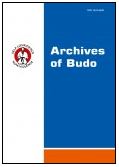2021, Volume 17
Body composition and motor potential of judo athletes in selected weight categories
Kazimierz Witkowski1, Magdalena Superson1, Paweł Piepiora1
1University School of Physical Education in Wrocław, Wrocław, Poland
Author for correspondence: Paweł Piepiora; University School of Physical Education in Wrocław, Wrocław, Poland; email: pawel.piepiora@awf.wroc.pl
Full text
Abstract
Background and Study Aim: Judo is a speed-strength discipline and requires a high level of motor preparation from competitors. Judo-related effort is general and activates more than 30% of the athlete’s body mass, both in the upper and lower body, but the flexor muscles of the arm and elbow are the most involved. The aim of the study was knowledge about the body composition of judo athletes and the level of tissue components. Taking into account the previous research and the characteristics of the effort in judo, a research hypothesis was adopted: the body composition of judo athletes has a significant impact on their motor potential.
Material and Methods: Fifty four judo athletes (training 6+ years) participated in the research. Body composition analysis was performed using a Tanita BC-418MA analyzer. Motor potential was determined by the International Physical Fitness Test (IPFT).
Results: The higher level of lean body mass of the examined judokas was accompanied by an increase in the level of adipose tissue. Among the group of championship class judo athletes was the associated with clearly noticeable significant differences in body composition compared to the other classes. The higher level of lean body mass of the tested judokas was accompanied by an increase in the level of adipose tissue. The championship class athletes were better prepared in terms of strength and speed abilities. Higher lean body mass generated higher levels of strength in athletes, but it was accompanied by a lower level of endurance.
Conclusions: The championship class athletes were better prepared in terms of strength and speed abilities. This may indicate a precise match to a given weight category of these judokas. Higher lean body mass generated higher levels of strength in judokas, but it was accompanied by a lower level of endurance. Therefore, in the training of all tested levels, attention should be paid to the development of this motor ability. Muscular hypertrophy and the related increase in body weight of the tested athletes with a decrease in the level of adipose tissue were a desired factor influencing the increase in motor potential.
Key words: dietetics, competition, adipose tissue, motor potential, training loads




